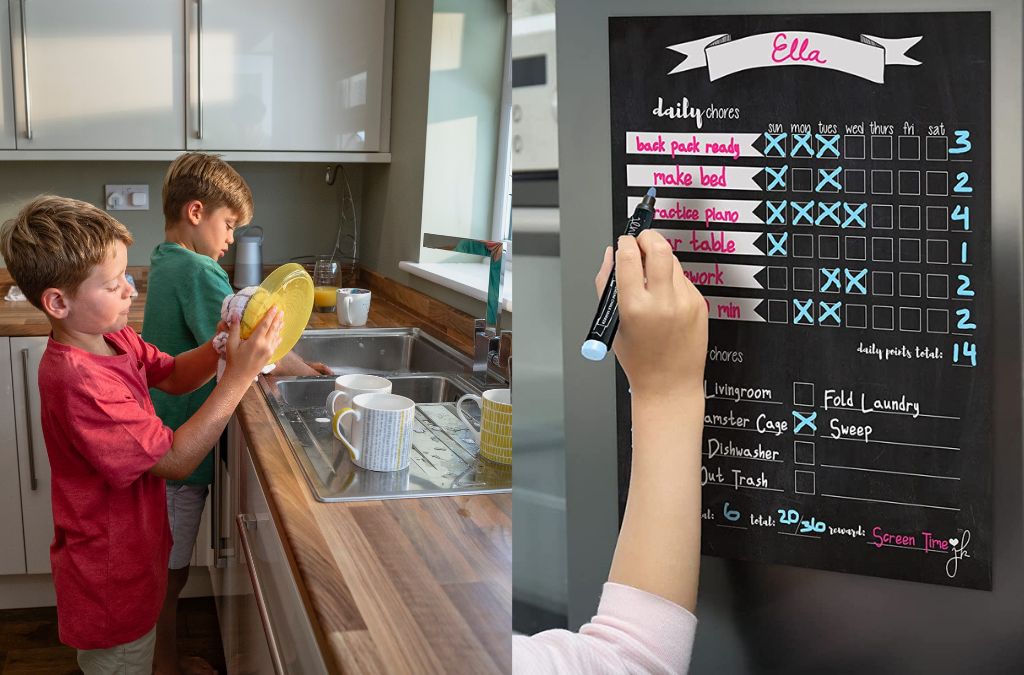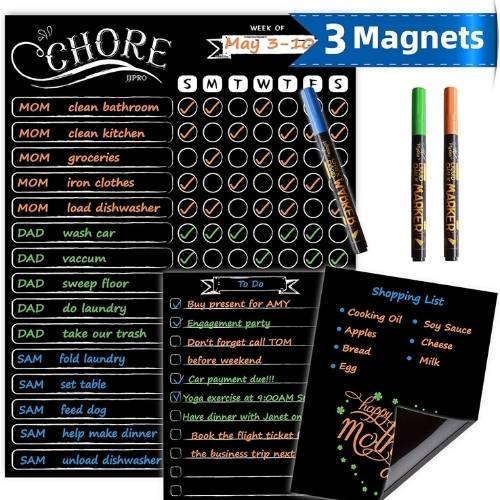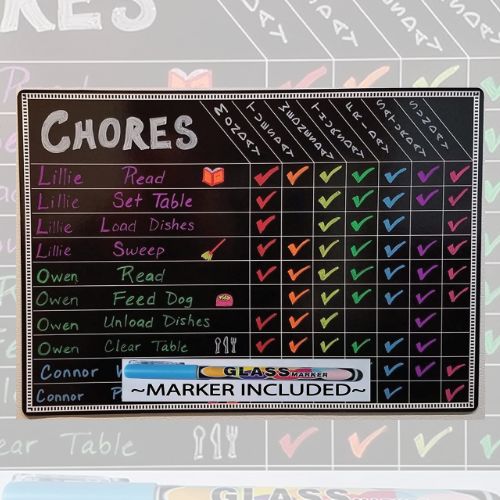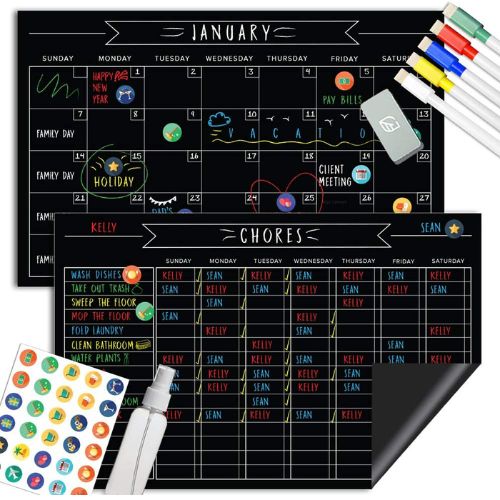A chore chart for kids is a fantastic way to motivate your kids! Not only does it encourage them to get their “everyday” chores done, you can use it to reward their accomplishments.
It can be very frustrating to have to remind your child over and over again to complete their chores. Often this is without them ever getting done!
When it comes to raising successful kids, one of the easiest things you can do is help them learn to track and celebrate their accomplishments. A chore chart for kids is a great way to do this.
In this blog post, we discuss the key benefits of chore charting kids’ accomplishments and how to get started!
The Key Benefits Of A Chore Chart For Kids
1. Learn To Set And Track Goals
One of the benefits of a chore chart is to help kids learn how to set and track goals. By being able to see their accomplishments over a week or month, they will better understand how progress is made. This is an important skill that will serve them well in all areas of their life. In fact, ask any successful person and they will tell you that setting goals is vital! Not only that, planning to achieve them and then ticking them off are true life skills.
2. Motivate And Inspire Kids
Another benefit of using a chore chart for kids is to motivate them to keep up the good work. When you celebrate their accomplishments, it will inspire them to continue working hard.
They learn the valuable lessons of planning, hard work, dedication and commitment.
3. Build Responsibility
By taking on the responsibility of completing their chores, they will learn to be accountable for their actions. Have daily chores, such as making their bed, as well as ones that need to be done within a week. These could include taking the trash out or tidying their room.
Not only does this give them choice around what they do, it makes them responsible. It is not you yelling at them to get something done now. It is them making the decision on when to do the task, knowing that there is a time limit on it.
This is an important lesson that will stay with them for years to come.
Using A Chore Chart For Kids’ Accomplishments
Now that you know the key benefits of a chore chart for kids, let show you how to use it to celebrate their accomplishments!
Step 1: Choose a chore chart that works for your kids. There are many different types of chore charts available, so take some time to find one that will work best for them.
Step 2: Determine how you will reward your child’s accomplishments. This is an important step as it will help to motivate them.
Step 3: Decide what tasks you would like your child to complete each day or week. Be sure to include simple tasks that they can easily accomplish. These will also depend on your childs age.
Step 4: Help your child to set goals for their chore chart. For example, they may want to aim to complete all of their weekly tasks in one day.
Step 5: Celebrate your child’s accomplishments! This can be done with a reward or by simply showing them how proud you are of their progress.
How To Make A Chore Chart For Kids
Making a chore chart for kids is easy! All you need is a whiteboard or piece of paper, some markers, and your child’s input. Here are the steps;
- Draw a large rectangle on the whiteboard or paper.
- Divide the rectangle into eight columns, one large and seven small.
- Write Chores on top of the large and each day across the small columns.
- Write your child’s name at the top of the chart.
- Ask your child what tasks are reasonable to complete each day. These can be simple tasks such as making their bed or brushing their teeth. Be sure to include a variety of tasks to keep them interested.
- Find 1-2 weekly tasks to include. For example, take the trash out or mow the lawn.
- Write the tasks in the appropriate columns on the chore chart for kids.
- Help your child to set goals for their chore chart. For example, they may want to aim to complete all of their weekly tasks in one day.
- Celebrate your child’s accomplishments! This can be done with a simple reward or by showing them how proud you are of their progress. Maybe a special dinner or trip to the cinema.
If you would like a store-bought one, there are many available. We have included 3 of the top-selling chore charts for kids.
Reward Accomplishments Using A Chore Chart For Kids
With your chore chart designed, it’s time to discuss the rewards for getting jobs done. You may choose to reward each individual task, or perhaps have a weekly amount when the chart has been filled. Either way will work and it is up to your family to decide what is best for you.
There are many different ways that you can reward your child’s accomplishments. Below are some expert tips from our families.
Food Rewards
You may want to consider giving them a small prize each time they complete all of their tasks for the week. Another option is to give them a special privilege, such as choosing what they would like for dinner. Whatever you decide, be sure to make it something that your child will look forward to.
Monetary Rewards
If your child wants to buy a new gaming headphone or a deck of baseball cards, learning the value of making money is an invaluable life lesson for kids. If you decide to use a monetary allowance, ensure it’s age-appropriate and granted on a regular basis. A good rule of thumb is 50 cents per year of age. So, an 8-year-old child would earn $4.00 per week if each chore on the list has been completed. If it has not been, they do not receive their full allowance.
However, they should be paid for the tasks that they have completed. This is a great opportunity for you to teach your children the value of both earning and saving money.
Perhaps the child can divide their allowance into thirds: 1/3 to spend, 1/3 to save, and 1/3 to use to help those less fortunate than themselves.
You might also want to consider designing a ‘bank book’ for each portion of the allowance. Store these in the 3 coffee cans or money jars. Each time you take money from the jar, have your child record it in the book. This way, your child will be able to keep track of how much they have spent. Further, they can see how much has gone to help someone else.

Other Non-Monetary Reward
Should you decide to use non-monetary incentives as chores payments, be sure you set clear parameters. They must understand that these rewards only come by completing the chore list successfully each week.
This could be two hours each weekend of their favorite video game or going to see a movie.
Consider writing these on a slip of paper as ‘currency’ for the child to keep in their ‘privilege bank’. They can cash these in with you whenever they’d like.
Regardless of the method you choose, keep in mind this can be a valuable tool for both you and your child.
Summary Conclusion
Using a chore chart for kids will teach them responsibility and the value of work. However, design it in such a way that works best for your child and your family.
Try to find rewards that fit both your child’s personality and your family budget. The amount of reward will be different for each family and does not have to include money itself. There are many ways to reward your childs hard work and dedication.
So,
- Chore charting can help kids learn responsibility and the value of work.
- When designing a chore chart, be sure to consider what will work best for your family.
- Rewards for completing tasks on a chore chart can be either monetary or non-monetary, depending on what will work best for your child.
What are some other benefits of using chore charts for kids? Let us know in the comments below!
Read more savings tips for families.
My name is Andrea Thompson and I’m a home based freelance writer. I’m 23 years old, married to my best friend, and mother to a wonderfully independent and opinionated 3 year old girl and step-mother to a sweet seven year old boy. I live in a tiny, little town in Kentucky, where I spend my free time fishing with my kids.
Writing has always been my passion, which I followed through high school, and for a while in college. Life happened, and once I discovered we were pregnant, I switched directions; opting for the healthcare industry because of the stability.
Finally, years later, I was in a place where I could leave the day job that never truly made me happy, and pursue my dreams. I’ve built, and am still building, my writing career from scratch. But, I’m passionate and I’m good at what I do. And, in the end, I can prove to my daughter that she can do anything she wants with this life.









